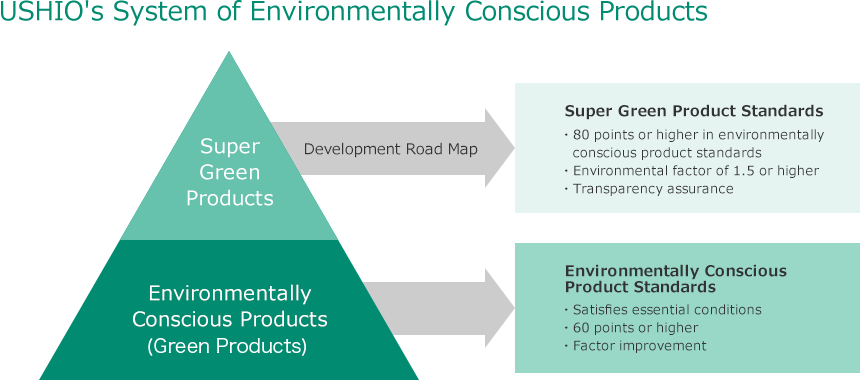Green Products: (SCOPE3 Category 11 reduction and environmentally conscious products)
Impacts on climate change span the entire business. In particular, manufacturers that provide energy-using products, such as Ushio, tend to have a higher percentage of the impact on climate change from the use of their products, which poses a significant risk. However, in a situation where various companies are tackling climate change, if they develop products that have less impact on climate change, we believe this will be an opportunity for customers to choose.
With the theme of creating safety, reassurance, and environmentally conscious solutions, Ushio has expanded this scope to include all business areas, including products, development, and services. In order to promote environmentally conscious design and development that contribute to energy saving, we have established energy saving items as one of our own certification standards for Super Green Products, and have been continually contributing to energy saving through the promotion of sales of certified products.
As a material issue, starting in fiscal 2021, we will continue our efforts to reduce CO2 emissions during product use as a priority issue. We will continue to develop energy-saving products, including super green products.
Plans for CO2 reduction by Environmentally Conscious Products development in fiscal 2021 and beyond
| Key Issue as 4th Management Focus Plan for FY2021 |
Promote reduction of SCOPE3(*1) CO2 emissions in line with the long-term target (2.54% per year reduction) * |
|---|---|
| Key Issue as 4th Management Focus Long-Term Targets |
Target for fiscal 2025: Reduce water usage by 3% compared to fiscal 2019 |
(*2) Product ratio of Green product and Super green product in the total number of assessments during new product development
Note: The efforts of the Green Product Committee in the 6th Environmental Action Plan were evaluated as an material issue in the identification of materiality.
Therefore, we will continue to address this issue as one of the themes of the fourth Management Focus from fiscal 2021.
Development of Environmentally Conscious Products
At Ushio, we incorporate our Environmentally Conscious Product Assessment Manual into our Design Standards so we can pre-evaluate the environmental impact of our products starting in the design stage. When the environmental performance of a product has been improved based on this evaluation, it is certified as an Environmentally Conscious Product. If a product is outstanding even among environmentally conscious products, and uses innovative environmental technology on a completely different level from existing products, it is certified as an SG product.

Development of Super Green Products
In line with its efforts to create environmentally conscious products and based on its own certification standards, Ushio designates products that proactively use environmental technologies as Super Green Products. Super Green Products are flagship products that demonstrate excellent environmental qualities, such as energy efficiency, extended lifetimes, 3R design, materials used, and applications. Ushio has certified 31 Super Green Products that have cleared numerical benchmarks based on the Ushio environmental factor.
In FY2016, Ushio proactively improved the environmental performance of product lines that take advantage of its unique strengths in light, certifying products such as optical measuring instruments, ultraviolet phototherapy devices for skin, LD light induced fluorescence light sources, ozone fumigators, LED light sources, UV irradiation units for hardening ink.
Evaluation Criteria of Super Green Products
The certification standard for Super Green products is comprised of the following three requirements.
1) Environmentally conscious product score of 80 or more (based on environmentally conscious product assessment standards)
2) Environmental factor of 1.5 or more (calculated in comparison to previous products, with FY2015 as the baseline year)
3) Attainment of transparency
Environmental Factor
Environmental factor is calculated by dividing the environmental efficiency of the target product by the environmental efficiency of the equivalent product in the baseline year. Ushio calculates a product's environmental efficiency by dividing product value (performance) by environmental impact. Product value is calculated by multiplying energy output by lifespan. Environmental impact is calculated with this formula: √ [(Energy input)²+(3R volume)²+(Chemical substances content)²]
-
Notes:
-
1. Energy output: For lamps, primarily lighting output and intensity. in the necessary wavelength range
-
2. Energy input: Energy consumed in using the product
-
3. 3R volume: Product size and weight (quantity of resources used)
-
4. Chemical substances content: Quantity of substances with environmental risk contained in the product. For example, if the environmental factor is α for a given product, it signifies the following improvements over the baseline year
-
・A product performance improvement by a factor of α, assuming the product environmental impact is held constant. A product environmental impact reduction by a factor of 1/α, assuming the product performance is held constant.
Actions Regarding Environmentally Friendly Products (Green Products)
When designing products, Ushio is required to conduct an environmentally friendly product assessment. This assessment of environmentally friendly products includes more than 60 points to be cleared, and we designate products that satisfy such necessary benchmarks, including improvement of environmental factors, as environmentally friendly products (green products).
Implementing LCA
No matter how much CO2 emissions are reduced at factories, these activities are not meaningful if CO2 emissions increase when the manufactured products are actually used by customers. Meanwhile, products can provide both cost and environmental benefits for customers if they use energy-efficient products. Therefore, to quantitatively measure the environmental impact of products and services over the entire lifecycle, Ushio formulated LCA guidelines in 2006 and has implemented LCAs ever since. In fiscal 2009, LCAs were implemented for all major Ushio lamp products. Going forward, we will expand LCA activities to various devices in order to satisfy the needs of customers.
